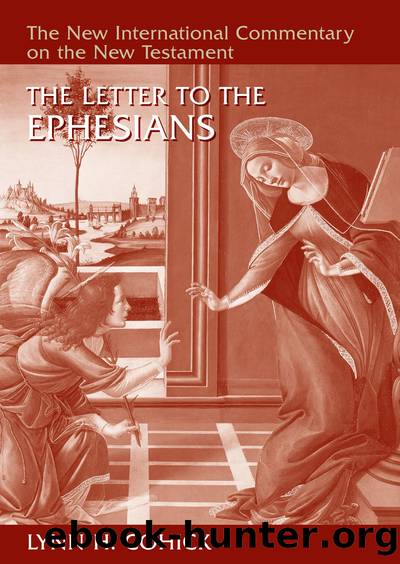The Letter to the Ephesians by Lynn H. Cohick

Author:Lynn H. Cohick
Language: eng
Format: epub
Publisher: Wm. B. Eerdmans Publishing Co.
Published: 2020-01-15T00:00:00+00:00
III. EXHORTATION TO HOLY LIVING (4:1â6:20)
Ephesians 4 begins the second half of the epistle, and Paul addresses proper Christian conduct consistent with the soaring theology presented in the first three chapters. In the paraenesis of Eph 4â6, the theological indicative drives the ethical imperative.1 The focus shifts from the redemptive act of God the Father in Christ the Son, expounded in Eph 1â3, to an ethical focus on the church and its health and growth in the epistleâs second half. Paul concentrates on how believers might live into their salvation and their calling to be holy and blameless (1:4; 4:1). A similar pattern of laying out doctrine and following with ethical injunctions is most clearly seen in Romans, wherein the first eleven chapters focus on theological questions, and the latter four on how these doctrines can be lived out in the church.2 Yet I must also point out that in Ephesians and Romans, the theologically rich chapters also contain hortatory injunctions.3 And Paul does not leave theology behind in the second half of Ephesians, for the didactic is infused with the kerygmatic, as seen by the continued reminder of Christâs efficacious work that makes a way for ethical behavior suitably reflective of Godâs kingdom (5:1â6).4
Paul encircles the second half of the epistle with references to his chains (4:1; 6:20). He writes this epistle while under house arrest that allows some visitors but restricts his movement and prevents him from preaching in the marketplace (Acts 28:16).5 Paul awaits an audience with the emperor, who might condemn him to death. For that reason, Paul asks the Ephesians to pray that he would be bold and fearless in preaching the gospel (Eph 6:20). Paul reminds the readers of his imprisonment to establish rapport between him and the Ephesians, as âwas also considered fundamental to hortatory discourse.â6
Unity is a key theme throughout the epistle. We saw earlier that Godâs ultimate goal is to bring all things together under Christ (1:10) and that Christ has brought together Jew and gentile into one community/body (2:14â16). The newly constituted body of Christ represents the wisdom of God to the heavenly powers and authorities (3:10). In this section of the letter, Paul focuses on the oneness of the people of God in Christ, urging behavior that matches the lofty truths expressed in the first three chapters. The social framework for this call is the liturgical life of the church, its confession of faith tied to life in the Holy Spirit (4:3, 30; 5:18) and to mature knowledge of the Son of God (4:13). Paul focuses on unity achieved by Christâs gift extended to every member (4:7), reinforced by putting on the new self (4:24). Paul highlights how unity is demonstrated by submitting to each other as to Christ (5:21) and standing firm in the armor of God against evil forces (6:11â13). Paul urges members to grow together, with Christ as their head (4:15â16), and to understand their oneness with Christ through the analogy of the âone fleshâ of husband and wife (5:32).
Download
This site does not store any files on its server. We only index and link to content provided by other sites. Please contact the content providers to delete copyright contents if any and email us, we'll remove relevant links or contents immediately.
The Five People You Meet in Heaven by Mitch Albom(3456)
Real Sex by Lauren F. Winner(2949)
Name Book, The: Over 10,000 Names--Their Meanings, Origins, and Spiritual Significance by Astoria Dorothy(2925)
The Secret Power of Speaking God's Word by Joyce Meyer(2919)
The Holy Spirit by Billy Graham(2877)
0041152001443424520 .pdf by Unknown(2768)
ESV Study Bible by Crossway(2725)
How The Mind Works by Steven Pinker(2712)
Ancient Worlds by Michael Scott(2607)
The ESV Study Bible by Crossway Bibles(2494)
Churchill by Paul Johnson(2493)
The Meaning of the Library by unknow(2485)
The Gnostic Gospels by Pagels Elaine(2459)
MOSES THE EGYPTIAN by Jan Assmann(2360)
Jesus by Paul Johnson(2294)
City of Stairs by Robert Jackson Bennett(2293)
The Complete Dead Sea Scrolls in English (7th Edition) (Penguin Classics) by Geza Vermes(2222)
Ancient Near Eastern Thought and the Old Testament by John H. Walton(2183)
The Nativity by Geza Vermes(2165)
